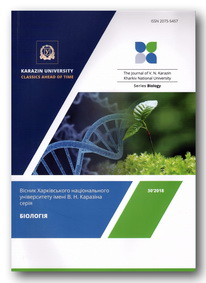Analysis of the low functional allele 7(TA) of the UGT1A1 gene in healthy population in the Western region of Ukraine
Abstract
Gilbert's syndrome, GS (non-hemolytic anemia) is a pathological condition caused by enzyme (uridine diphosphate glucuronosyltransferase) failure to degrade bilirubin because of UGT1A1 gene mutations, which generally are TA insertions in the promoter region. Disorder entails constantly high level of bilirubin in the blood, and its toxicity causes symptoms manifestation. The pathology doesn’t require therapy, but it increases the risk of concomitant disorders and requires a special approach when prescribing therapy with drugs. The frequency of Gilbert's syndrome ranges from 0.6% to 43% worldwide, the frequency in Ukraine is not known exactly. Thus, the aim of the work was, based on analysis of published data, to study the world distribution of Gilbert's syndrome risk alleles, to find their associations with other pathological conditions, and to establish the frequency of the low-functional allele and various genotypes in TA [A(TA)6TAA] locus of UGT1A1 gene among residents of the Western region of Ukraine. Blood samples from 130 healthy residents of the Western region of Ukraine were collected, DNA samples were isolated by salting method. DNA amplification was performed by PCR followed by 10% PAG analysis and HRM analysis (high resolution melting). The pathogenic allele frequency was 34.3%, the frequency of the ancestral allele was 65.7%. The frequency of the mutant homozygous genotype was 14.6%, which coincides with published data. The frequency of the mutant genotype equals 8–18% for European countries, so our data coincide with results of population studies of European countries residents. It should be noted that these 14.6% of population are of high risk of concomitant disorders, such as colorectal cancer in men, breast cancer in women, diseases of the gastrointestinal tract, biliary calculus and formation of kidney stones. Thus, it is advisable to analyze 7(TA) alleles (risk alleles for Gilbert's syndrome) of the UGT1A1 gene in patients with hyperbilirubinemia of undetermined origin to diagnose Gilbert's syndrome.
Downloads
References
Макух Г., Заставна Д., Тиркус М. Спосіб виділення ДНК з лейкоцитів периферійної крові. Патент 32044 UA, MПK G01N33/49 (2006.01). ДУ «Інститут спадкової патології НАМНУ». №u200801896. Заявл. 14.02.2008. Опубл. 25.04.2008. Бюл. №8. /Makukh H., Zastavna D., Tyrkus M. A method of isolating DNA from peripheral blood leukocytes. Patent 32044 UA, MPK G01N33/49 (2006.01). SI Institute of Hereditary Pathology NAMSU. No. u200801896. Declared 14.02.2008. Published 25.04.2008. Byul. No.8./
Bajro M., Josifovski T., Panovski M. et al. Promoter length polymorphism in UGT1A1 and the risk of sporadic colorectal cancer // Cancer Genet. – 2012. – Vol.205 (4). – P. 163–167.
Buch S., Schafmayer C., Volzke H. et al. Loci from a genome-wide analysis of bilirubin levels are associated with gallstone risk and composition // Gastroenterology. – 2010. – Vol.139 (6). – P. 1942–1951.
Hemmati F., Saki F., Saki N., Haghighat M. Gilbert syndrome in Iran, Fars Province // Annals of Saudi Medicine. – 2010. – Vol.30 (1). – P.84.
Kadlckova L., Danzig V., Cifkova R. Prevalence of Gilbert syndrome and UGT1A1*28 status in the Czech population, and their relationship to ischemic heart disease // Atherosclerosis. – 2014. – Vol.235 (2). –e285–e286.
Kaniwa N., Kurose K., Jinno H. et al. Racial variability in haplotype frequencies of UGT1A1 and glucuronidation activity of a novel single nucleotide polymorphism 686C>T (P229L) found in an African-American // Drug Metab. Dispos. – 2005. – Vol.33. – P. 458–465.
Claridge L.C., Armstrong M.J., Booth C., Gill P.S. Gilbert’s syndrome // BMJ. – 2011. – Vol.342. – d2293.
Marinković N., Pasalić D., Grsković B. et al. Genotype frequencies of UDP-glucuronosyltransferase 1A1 promoter gene polymorphism in the population of healthy Croatian pre-scholars // Coll. Antropol. – 2008. – Vol.32 (3). – P. 725–729.
Mlakar S., Ostanek B. Development of a new DHPLC assay for genotyping UGT1A (TA)n polymorphism associated with Gilbert’s syndrome // Biochem. Med. (Zagreb). – 2011 – Vol.21 (2). – P. 167–173.
Radlović N., Ristić D., Brdar R. et al. Association of hereditary elliptocytosis and Gilbert’s syndrome as the cause of biliary calculosis: case report // Srp. Arh. Celok. Lek. – 2011. – Vol.139 (5–6). – P. 386–389.
Rolf H., Vossen M., Aten E. et al. High‐Resolution Melting Analysis (HRMA) – more than just sequence variant screening // Human Mutation. – 2009. – Vol.30 (6). – P. 860–866.
Sieg A., Arab L., Schlierf G. et al. Prevalence of Gilbert's syndrome in Germany // Dtsch. Med. Wochenschr. – 1987. – Vol.112 (31–32). P. 1206–1208.
Starlard-Davenport A., Word B.R., Lyn-Cook B. Characterization of UDP-glucuronosyltransferase (UGT1A1) promoter polymorphisms and gene expression on ethnicity, stage of disease, and menopausal status in breast cancer // J. Drug Metabol. Toxicol. – 2012. – Vol.2012 (suppl. 4). – doi:10.4172/2157-7609.S4-001.
Vukovic M., Radlovic N., Lekovic Z. et al. UGT1A1 (TA)n promoter genotype: diagnostic and population pharmacogenetic marker in Serbia // Sciendo. – 2018. – Vol.21 (1). – P. 59–68.
Wasmuth H., Keppeler H., Herrmann U. et al. Coinheritance of Gilbert syndrome-associated UGT1A1 mutation increases gallstone risk in cystic fibrosis // Hepatology. – 2006. – Vol.43 (4). – P. 738–741.
Authors retain copyright of their work and grant the journal the right of its first publication under the terms of the Creative Commons Attribution License 4.0 International (CC BY 4.0), that allows others to share the work with an acknowledgement of the work's authorship.




